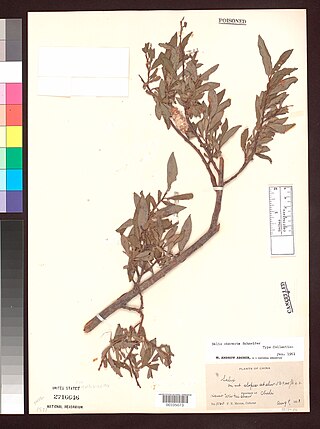
Salix argyracea is a large shrub from the genus of willow (Salix) with up to 10 centimeters long leaf blades with a felty hairy and shiny underside. The natural range of the species is in Kazakhstan, Kyrgyzstan, and China.
Salix capusii is a large shrub from the genus of the willow (Salix) with chestnut-brown branches and 4 to 5 centimeters long, gray-blue leaf blades. The natural range of the species is in Afghanistan, Tajikistan, Pakistan, and China.
Salix cathayana is a strongly branched shrub from the genus of the willow (Salix) with brown or gray-brown, young tomentose hairy branches. The leaf blades have lengths of 1.5 to 5.2 centimeters. The natural range of the species is in the north of China.
Salix balfouriana is a shrub or small tree from the genus of willow (Salix) with reddish black and tomentose hairy young twigs and up to 8 leaf blades, rarely 18 centimeters long. The natural range of the species is in China.
Salix annulifera is a small shrub from the genus of the willow (Salix) with up to 8 centimeter long leaf blades. The natural range of the species is in China.
Salix boseensis is a shrub from the genus of willow (Salix) with initially brownish, frosted and bare branches and 6 to 9 centimeters long leaf blades. The natural range of the species is in China.
Salix atopantha is a small shrub from the genus of the willow (Salix) with up to 4 centimeters long, dull brown leaf blades on top. The natural range of the species is in China.
Salix chienii is a large shrub or small tree in the willow genus Salix with initially light green and tomentose hairy and later reddish brown and balding branches. The leaf blades have lengths of 2 to 3.5 sometimes 5.5 centimeters. The natural range of the species is in China.
Salix chikungensis is a shrub in the willow genus Salix with tomentose hairy and later balding branches. The leaf blades have lengths of 6 to 8.5 centimeters. The natural range of the species is in China.

Salix cavaleriei is a large tree from the genus of willow (Salix) with a gray-brown, furrowed bark. The leaf blades have lengths of 4 to 11 centimetres. The natural range of the species is in China. It is planted for logging and for fastening embankments.

Salix characta is a shrub from the genus of willow (Salix) with initially downy hairy branches. The leaf blades have lengths of 3.5 to sometimes 7 centimeters. The natural range of the species is in China.

Salix cheilophila is a shrub or small tree from the genus of willow (Salix) with initially tomentose hairy and later balding branches. The leaf blades have lengths of 2.5 to sometimes 6 centimeters. The natural range of the species is in China.
Salix crenata is a cushion-shaped growing shrub from the genus of willow (Salix) with about 8 millimeter long leaf blades. The natural range of the species is in China.
Salix cupularis is a small shrub from the genus of the willow (Salix) with 1.5 to 2.7 centimeters long leaf blades. The natural range of the species is in China.
Salix daliensis is a shrub from the genus of willows (Salix) with mostly 5 to 6 centimeters long leaf blades. The natural range of the species is in China.
Salix daltoniana is a shrub or small tree from the genus of the willow with mostly 4.5 to 9 centimeters long leaf blades. The natural range of the species is in India, Nepal, Bhutan, and in Tibet.
Salix delavayana is a shrub or small tree from the genus willow (Salix) with mostly 3 to 8 centimeters long leaf blades. The natural range of the species is in the south of China and in Tibet.

Salix driophila is a shrub from the genus of willow (Salix). The natural range of the species is in China.

Salix erioclada is a species from the genus of willows (Salix) and grows as a shrub or small tree. The leaf blades have a length of about 5 centimeters. The natural range of the species is in China.
Salix blakii is a willow (Salix) shrub with thin, brownish and bare branches and 4 to 8 centimeters long leaf blades. The natural range of the species extends from Southwest Asia to China.






